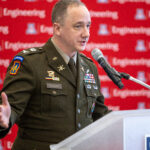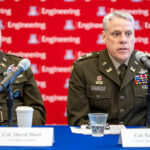Dear Members and Friends,
“Just a great honor to be here. Great honor to be in Tucson. Thank you to the University of Arizona. This is about building cauldrons of excellence. This is about winning big. I want you to dream big, be big, and start a cauldron right here in this university, in the state of Arizona, to lead the world and lead our nation on Near Space. Nobody’s doing it at this level. It’s about being at the right place at the right time for the right reasons with the right people.”
- Mr. Riki Ellison at the Arizona Near Space Forum in Tucson on April 19, 2024.
“The University of Arizona has a long history of big science and engineering. We successfully take on challenges, recent OSIRIS-REx, asteroid sample return mission, we’re leading in space domain awareness, and you’ll hear more about that. We’re building the future quantum internet and we’re tackling the challenges of hypersonic research from aerodynamics to guidance navigation and control to materials and directed energy. Similarly, the Missile Defense Advocacy Alliance has decades of experience as an advocate for the development and deployment of systems to defend the United States and its allies. So we come together today to focus on the opportunities in the regime of Near Space.”
- Dean David Hahn, University of Arizona College of Engineering, at the Arizona Near Space Forum in Tucson on April 19, 2024.
“The time is now to look at that type of technical breakthrough, and that’s in this area. This is not about exquisite systems here. This is about being able to save billions of dollars on overhead persistent with what we do with caps on aircraft. But we got to get rid of that. We’ve got to be able to identify all these threats. That’s what we’ve got to do here on top. So it’s the right time in the world for this. This is the right place because this school has one of two in the country universities that has a hypersonic wind chain. It’s a five mach. I think it’s going to go to six, but it’s getting there. And we’ve got a balloon expertise here. We’ve got the border there. You’ve got Goldwater range. You need a Near Space Spaceport in Arizona.”
“You need air corridors to fly hypersonics, long range missiles to White Sands, to California, to PRMF in Hawaii. You have everything here that we believe can lead and take advantage of for the nation. And it’s the right people. I know we’ve got a lot of people in this room. And you build your team on it. You build it. This is about people. This is about relationships. This is about number one on all those championships. It’s about trust within the locker room.”
“And certainly in Near Space, there is no policy against putting a directed energy laser on an air platform there. That’s where the dynamics play the best, the atmosphere plays the best. We got to look at this stuff. We got to understand it. We got to study it. We got to figure out how to power it, how to maneuver it, how to get the right weight, but time has come and you’re on it, and our country’s going to spend a lot of money on this.”
- Mr. Riki Ellison at the Arizona Near Space Forum in Tucson on April 19, 2024.
“Well, thanks Riki for the chance to go first. You start with what we are trying to accomplish and what we are threatened by in your space domain. On what are we threatened by part because policy, again, for those that did not hear me earlier, what you are really trying to do first is conceptualize what are the threats we care about, why? What are we trying to be as a country and what is the role of military forces in that policy in relation to the other elements of national power? And then how do we want to work? What is the character of the force that we need to accomplish our strategies from what are your ambitions and what threats you care about, should flow your strategy, which should define therefore your military plans, which should drive requirements, which should drive them to acquisition programs. And that is in theory the way it should work. But where we need to get our heads around the near space domain is not a lot of thought was given that before because this seam area between very high altitude and space was just not something we were exploiting in a noteworthy way.”
“Innovation does not happen, as I mentioned earlier, just in the United States, China with this very high-altitude balloon with others, they have shown the possibilities there. And I think we’ll continue to exploit that because while we’re very self-centered and focused on we in the United States and only two aircraft that could potentially go up there, like Corky was saying, with the F-22 or the U-2, which is on our put yourself in the shoes of our other major allies if you’re in England or France, Japan, that means you have no assets that can fly those altitudes to observe and zero effectors.”
“And so, while China wants to gather information and intelligence on us and potentially add effectors to those platforms, they also want to do this with others. Whether you say what are the threats that you’re concerned about, I think we should be concerned very much about that threat because of whether it’s persistent intelligence collection with the ability to collect signals intelligence or other things today, those same amateurs, those same sources can also be used for effects, electronic effects and otherwise. And then if you think about kinetic platforms such as space-based, in this case near-space, weapons being based there could be very effective.”
- Mr. John Rood at the Arizona Near Space Forum in Tucson on April 19, 2024.
“Yeah, just real quick. The requirements do come from the COCOMs and our number one priority is Homeland defense. But this near-space we talk about is over the entire globe and every COCOM cares about it.”
“I just described a crap show of budget for the missile defense of the Homeland. The only way it’s not a crap show is if we could – can build sensors and effectors that are in space because the geographic coverage area of a sensor and effector from space is volumetrically, it is exponentially higher as a matter of volume. And so suddenly you can for a reasonable, this is how we should think about near-space opportunity. It’s the opportunity to solve the cluster of hypersonics, the cluster F of Homeland defense, all the clusters we see out there. And it would be critical for JADC2, it would be enhancing for JADC2.”
“It would work alongside the LEO satellite networks we’re putting up and a little bit of the geo that helps with this and the aircraft that help with it. By the way, one more reason for the air force or space force… And this is where I think… The only way we can convince the air force to take this mission is imply that the Space Force may want it. And the Air Force would be like, “I got it.” But I think we should reorient how we think about near-space and say this is the land of opportunity. This is how we solve these really complex problems or these really financially crushing problems with American technology.”
“So Air Force needs to, I think they probably need to own this. Now we’re saying something that’s completely… I mean Frank Kendall can double back cheat the back flips out of the boom you secretary of the Air Force because he can’t do everything he’s supposed to do right now with the budget he has. Whoever gets this mission is probably going to get almost no additional resources to handle it. And because it’s a new program start, with probably a midterm version and a long-term version, it’s going to be expensive.”
“I think that’s it. Now look, here’s the second part, as he had mentioned. There’s a chance we’re going to put weapons up there. Now Air Force will run for that, air Force would be like, sprint… They’ll cut the armies before the race starts to get to that, right? They’ll say, you can’t shoot from its face, our aircraft are below you, you’ll kill us, we don’t trust you. All the Patriot versus F-16 will come back up again. All that stuff. So my gut reaction is I think the Air Force is.”
- RADM (Ret.) Mark Montgomery at the Arizona Near Space Forum in Tucson on April 19, 2024.
“We’re going to take all the ideas and thoughts that have happened today and make hay with it. We got to have an action plan, we got to work. And the number one thing we have to address is the policy. We know this is a legitimate thing here. Nobody wants to own your space because nobody wants to pay for your space.”
- Mr. Riki Ellison at the Arizona Near Space Forum in Tucson on April 19, 2024.
“There’s an urgent need for continued investment in missile defense technologies and strategies to effectively mitigate the growing ballistic missile, cruise missile and hypersonic missile threats. Failure to address this escalating threat will have devastating consequences for national security and global stability.”
- Heidi Shyu, Undersecretary of Defense for Research and Engineering, at the National Defense Industrial Association’s 2024 Missile Defense Conference in Washington on April 16, 2024.





